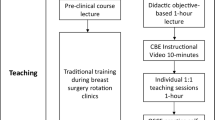Abstract
Clinical breast examination (CBE) is traditionally taught to third-year medical students using a lecture and a tabletop breast model. The opportunity to clinically practice CBE depends on patient availability and willingness to be examined by students, especially in culturally sensitive environments. We propose the use of a hybrid simulation model consisting of a standardized patient (SP) wearing a silicone breast simulator jacket and hypothesize that this, compared to traditional teaching methods, would result in improved learning. Consenting third-year medical students (N = 82) at a university-affiliated tertiary care center were cluster-randomized into two groups: hybrid simulation (breast jacket + SP) and control (tabletop breast model). Students received the standard lecture by instructors blinded to the randomization, followed by randomization group-based learning and practice sessions. Two weeks later, participants were assessed in an Objective Structured Clinical Examination (OSCE), which included three stations with SPs blinded to the intervention. The SPs graded the students on CBE completeness, and students completed a self-assessment of their performance and confidence during the examination. CBE completeness scores did not differ between the two groups (p = 0.889). Hybrid simulation improved lesion identification grades (p < 0.001) without increasing false positives. Hybrid simulation relieved the fear of missing a lesion on CBE (p = 0.043) and increased satisfaction with the teaching method among students (p = 0.002). As a novel educational tool, hybrid simulation improves the sensitivity of CBE performed by medical students without affecting its specificity. Hybrid simulation may play a role in increasing the confidence of medical students during CBE.


Similar content being viewed by others
References
Miller AB (2010) Screening for breast cancer in the Eastern Mediterranean Region. East Mediterr Health J Rev Santé Méditerranée Orient 16(10):1022–1024
Saslow D, Hannan J, Osuch J, Alciati MH, Baines C, Barton M (2004) Clinical breast examination: practical recommendations for optimizing performance and reporting. CA Cancer J Clin 54(6):327–344
Coleman EA, Stewart CB, Wilson S, Cantrell M, O’Sullivan P, Carthron D (2004) An evaluation of standardized patients in improving clinical breast examinations for military women. Cancer Nurs 27(6):474–482
Costanza ME, Luckmann R, Quirk ME, Clemow L, White MJ, Stoddard AM (1999) The effectiveness of using standardized patients to improve community physician skills in mammography counseling and clinical breast exam. Prev Med 29(4):241–248
Pugh CM, Salud LH (2007) Fear of missing a lesion: use of simulated breast models to decrease student anxiety when learning clinical breast examinations. Am J Surg 193(6):766–770
Dilaveri C, Szostek JH, Wang AT, Cook D (2013) Simulation training for breast and pelvic physical examination: a systematic review and meta-analysis. BJOG Int J Obstet Gynaecol 120(10):1171–1182
Goldstein MK, Mehn MA, Pennypacker HS, Brost BC, Petersen, W.O., Nicometo, A.M., MammaCare and Mayo Clinic (2012) Improved clinical breast examination competencies via intelligent simulator training. Meeting of the German Society for Senologie, Stuttgart
Bickley LS (2005) Volume 12: breast and axillae in bates’ visual guide to physical examination, 10th ed. Lippincott Williams & Wilkins, Philadelphia
Edwards SJL, Braunholtz DA, Lilford RJ, Stevens AJ (1999) Ethical issues in the design and conduct of cluster randomized controlled trials. BMJ 318(7195):1407–1409
El Hage Sleiman AK, Nassif J, Nassar A, Naamani S, Sharara-Chami R (2015) Hybrid simulation of clinical breast examination: a culturally sensitive tool. In: IPSSW 2015 book of abstracts. Vancouver: International Pediatric Simulation Society; [cited 2016 Apr 3]. p. 67–8. Available from: http://ipssglobal.org/wp-content/uploads/2015/08/IPSSW-2015-Book-of-Abstracts-22-April.pdf
Howley L, Szauter K, Perkowski L, Clifton M, McNaughton N, on behalf of the Association of Standardized Patient Educators (ASPE) (2008) Quality of standardized patient research reports in the medical education literature: review and recommendations. Med Educ 42(4):350–358
Schubart JR, Erdahl L, Smith JS, Purichia H, Kauffman GL, Kass RB (2012) Use of breast simulators compared with standardized patients in teaching the clinical breast examination to medical students. J Surg Educ 69(3):416–422
Piessen G, Louvet A, Robriquet L, Bailleux E, Jourdain M, Cosson M (2014) Setting-up and evaluation of an educational program for the teaching of breast and pelvic examination in undergraduate medical students: the “PRESAGE” simulation center experience of the medicine university of Lille, France. Gynécologie Obstétrique Fertil 42(9):591–596
Cook DA, Hamstra SJ, Brydges R, Zendejas B, Szostek JH, Wang AT, Erwin PJ, Hatala R (2012) Comparative effectiveness of instructional design features in simulation-based education: systematic review and meta-analysis. Medical Teacher 35(1):e867–e898
Acknowledgements
We would like to thank Ms. Randa Farha from the simulation laboratory at the American University of Beirut, the standardized patients who participated in this study, and Dr. Zavi Lakissian for assistance in submission of the manuscript. Institution where the research was conducted: American University of Beirut, Beirut, Lebanon.
Funding
Internal grant from the American University of Beirut.
Author information
Authors and Affiliations
Corresponding author
Ethics declarations
This is a randomized controlled blinded behavioral trial aiming at assessing the efficacy of hybrid simulation of CBE as an educational tool. It was approved by the Institutional Review Board (IRB) at the American University of Beirut.
Conflict of Interest
The authors declare that they have no conflict of interest.
Additional information
ClinicalTrials.gov Identifier: NCT02125487
Electronic Supplementary Material
ESM 1
(PDF 89 kb)
Rights and permissions
About this article
Cite this article
Nassif, J., Sleiman, AK., Nassar, A.H. et al. Hybrid Simulation in Teaching Clinical Breast Examination to Medical Students. J Canc Educ 34, 194–200 (2019). https://doi.org/10.1007/s13187-017-1287-3
Published:
Issue Date:
DOI: https://doi.org/10.1007/s13187-017-1287-3




